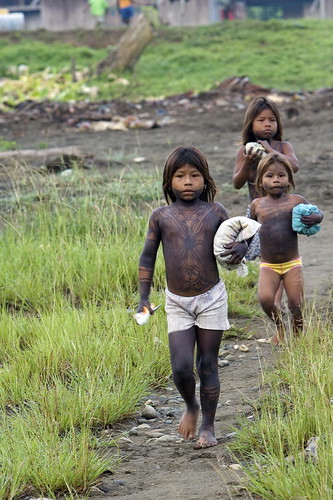Check out these Indigenous images:
Indigenous peoples' market in the Chittagong Hill Tracts, Bangladesh 
Image by jankie The Chittagong Hill Tracts (CHT) in southeastern Bangladesh bordering Burma is the ancestral domain of a dozen indigenous communities collectively known as the Jumma peoples (from “jum†= shifting cultivation). These peoples have ethnic, linguistic and religious identities totally different from the Bengali Muslim majority. Under British rule, the region was autonomous, largely off-limits to outsiders and almost exclusively inhabited by indigenous peoples. This special status gradually eroded after inclusion in East Pakistan in 1947. In the early 1960’s, the USAID-funded Kaptai hydroelectric dam inundated 40% of the arable land and forced relocation of a fourth of the population. After Bangladeshi independence from Pakistan in 1971, indigenous leaders’ appeals to the new government for autonomy and constitutional recognition were rejected. Subsequent governments opted for a military escalation of the area that triggered a protracted armed conflict. The government resettled more than 400,000 landless Bengalis into the region to outnumber the indigenous population and overwhelm the resistance. A series of massacres forced around 90,000 indigenous people to flee as refugees to neighboring India and Burma, and even more to become internally displaced. Thousands were killed, vast lands were grabbed by settlers and vested interests, and the demographics changed drastically. Even as the war raged, the Asian Development Bank funded rubber and tree plantations that removed indigenous people from their self-subsistent lifestyle, and road construction facilitating access to the more than 500 military camps in the region. Rampant illegal logging and shortened fallow cycles caused serious depletion of the forests. International concern over massive human rights violations and the plight of the refugees led to negotiations and a cease-fire, culminating in the 1997 CHT Peace Accord between the secular Awami League regime and the PCJSS/Shanti Bahini, the indigenous peoples’ political front and armed wing. The accord promised an end to hostilities, regional autonomy through devolution of powers to indigenous-controlled councils, return of occupied lands, withdrawal of most army facilities, and rehabilitation of indigenous refugees, internally displaced people and former combatants. But few of these promises were fulfilled in subsequent years, particularly under the alliance government (2001-2006) of the Bangladesh Nationalist Party and Jamaat-i-Islam, which had opposed the accord, and the subsequent caretaker government. The situation was further complicated by bloody internal strife between the PCJSS and the UPDF, a Jumma political party (formed in 1998) that rejected the accord in favor of “full-autonomy†within the state of Bangladesh. Communal attacks and land grabbing continued unabated. In the December 2008 elections, the Awami League won a landslide victory on a platform including a pledge to fully implement the CHT Peace Accord. The new government has taken a number of positive steps such as (re-)establishment of relevant committees, cancellation of unused plantation leases and withdrawal of an army brigade and 35 temporary military camps. But settlers have challenged the constitutionality of the accord in the courts, and vested interests are fighting to preserve the status quo. The government’s remaining four year tenure will likely determine the fate of the accord. A petition for full implementation of the CHT Peace Accord to help the indigenous Jumma peoples regain control over their forests, lands, and destiny at has been presented to Prime Minister Sheikh Hasina on 21 March 2010 by two Japanese MPs. The petition was signed by 35,757 people from 105 countries and 12 autonomous territories. The statement also has peace messages from 2754 people including 1976 Nobel Peace Prize winner Mairead Corrigan-Maguire.
Internally Displaced Indigenous in Colombia 
Image by United Nations Photo A view of indigenous children from the Embera people, displaced by armed conflict. There are over two million internally displaced persons in Colombia and while forced displacement is always a very difficult experience, it is doubly catastrophic for indigenous communities. Indigenous culture is closely linked to the land and displacement often leads to the total collapse of traditional authority and cultural patterns. 14/Jun/2006. UN Photo/Mark Garten. www.unmultimedia.org/photo/











0 comments:
Post a Comment